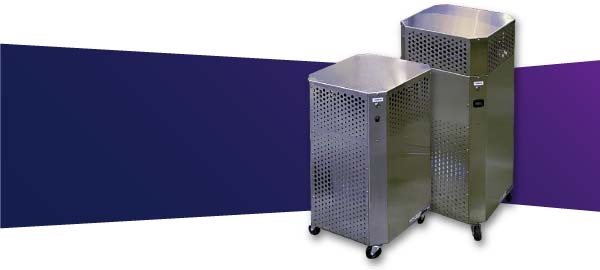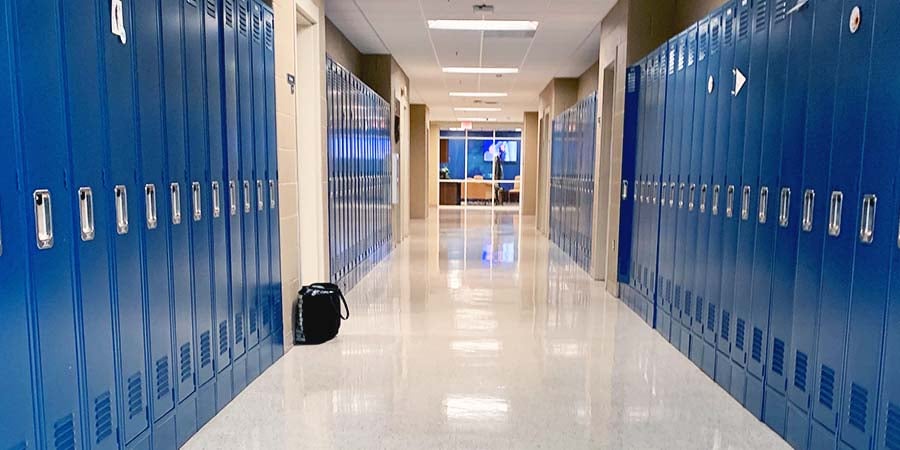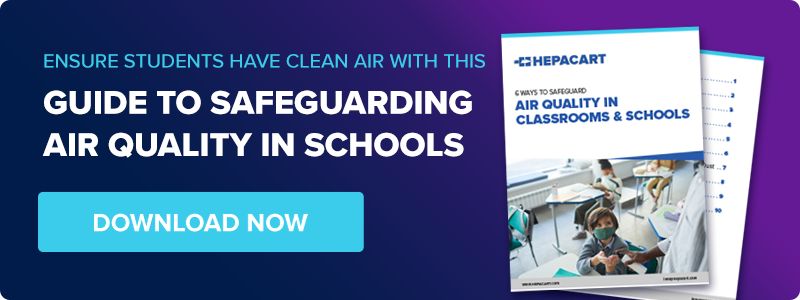Share this
How To Meet Indoor Air Quality Standards for Schools
by HEPACART on Feb 23, 2022
Mitigate poor indoor air problems until permanent solutions are possible — here’s how.
Developing minds need to be protected. Not just from obvious threats, but more subtle ones, too. As you spend time creating emergency plans, maintenance schedules, and more, think about air quality, too. The mean age of school buildings in America is 42 years, and 28% of them were constructed before 1950. This means that compounds and substances we’ve since learned are harmful, like asbestos, VOCs, and formaldehyde, still lurk in many of these buildings. As they age, these compounds are released into the air, whether due to off-gassing, renovations, or damage, leading to poor indoor air quality in classrooms.
Ultimately, it would be best to eliminate all these harmful substances from every building or build new ones from the ground up. Unfortunately, we can’t just get rid of every old building between one school day and the next, so we’ll have to mitigate the problems another way until it’s possible to have permanent solutions.

Other Air Pollution Sources
The bad news is that old buildings aren't the only problem. Outdoor pollution is a problem, too. Being in high traffic areas, such as next to a highway or in a city, means exhaust emissions that find their way into school buildings. A school could be near a farm that sprays chemicals or fertilizer or perhaps near a rendering plant or paper mill. All the particulates from these places can make their way into your school building and your classrooms.
That's not it, either. Other environmental factors include dust and mold. From improper HVAC maintenance and inadequate ventilation to airborne mold spores and school construction dust, many things can cause children, teachers, and staff to get sick and stay sick for the duration of the school year if the problems aren't addressed. And, of course, we're still battling the ongoing effects of COVID-19 and its highly contagious variants.
Is It That Big of a Problem?
The Healthy Schools Network, Inc. reports that air pollution can be up to 100x higher indoors than outdoors. Because the average person spends 90% of their time indoors, and students spend up to 40 hours a week sitting in classrooms, this can expose them to much higher levels of air pollution than they would otherwise. On top of this, 4.8 million of those school children suffer from asthma which can be aggravated by environmental pollutants.

It’s become more important than ever to remove pollutants and pathogens from the air before it reaches the lungs of students, faculty, and staff. Unfortunately, the U.S. Government Accounting Office and U.S. Department of Education say that to improve indoor air quality standards for schools, around 33% of school buildings need repairs or updates.
How Do We Fix It?
Air quality in classrooms can be improved quickly with new ventilation and filtration systems. Let’s start with ventilation first. Depending on the source of your air pollutants, you may want to add one of the following types of ventilation systems:
- Positive Air Pressure: This brings in fresh air from the outside. Because it increases the pressure in the building, this pushes the old air out. It usually requires installing new air ducts for the air to escape.
- Negative Air Pressure: This sucks the air in the building outside. If your building is having any of the off-gassing or damage issues that would lead to harmful substances getting into the air, this is an excellent solution. However, fresh air does need to come from somewhere.
- Balanced Pressure: This takes care of that “fresh air from somewhere” problem with negative pressure systems. Balanced pressure systems are basically combinations of positive and negative pressure setups. Old air is sucked out; new air is piped in.
Use HEPAFORCE® GermBuster Room Air Purifiers
You might notice that none of those systems mentions filtering the air itself. As important as it is to use disinfecting sprays that kill germs and molds and destroy viruses, adding more chemicals to indoor air isn't ideal. They aren't designed to interact with the human body any better than they do with the nasty diseases we want to eliminate. As part of a comprehensive cleaning solution, air purification is essential, especially if you're going to achieve the best indoor air quality standards for schools.

With HEPAFORCE GermBuster Room Air Purifiers, you can provide every populated room in your school with clean air. Whether you choose our GermBuster 300 or GermBuster with UV-FORCE, both have a HEPA filter to trap 99.97% of airborne particles larger than .3 microns. It's these particles that viruses such as COVID-19 like to hitch a ride on when they're floating through the air. They also collect other nasty stuff you don't want to breathe, like asbestos particles, pollen, dander, smoke, and dust mites.

But What About My Budget?
We understand tight operations budgets. And we know that a school with multiple campuses can be a lot to manage. Instead of purchasing and keeping track of numerous room air purifiers, which can be expensive and time-consuming, we offer a subscription service that places GermBuster 300 Room Air Purifiers in your school wherever you need them most for a low monthly cost. You don’t have to do a thing — just place them and go about your work.
By adding HEPA filtered room air purifiers to your comprehensive infection prevention plan, you’re preventing absences by reducing the number of ways people can get sick. And that’s not just students — that’s faculty and staff, too. You won’t need to rely on substitute teachers as much, and you’ll reduce the number of visits to the school nurse. It’s a win-win scenario. Best of all, you’re keeping those budding young minds in classroom seats, learning and socializing, instead of being stuck at home, sick in bed.
Improve Indoor Air Quality Standards for Schools in Your Care
Creating safe and breathable air that's free of germs and pollutants is what the GermBuster 300 is designed to do. If you have questions about budgeting, installation, or maintenance or would like to subscribe to our GermBuster 300 plan, we'd love to talk. You can also reference our 10 Ways To Protect Classroom Air Quality in Schools, which we've put together so you can have a handy reference.
More Reading:


